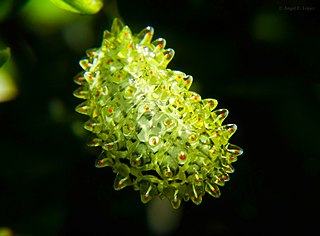Acraga andina is a moth of the family Dalceridae. It is found in Andes Mountains of Venezuela, Colombia, Ecuador and Peru. The habitat consists of tropical wet, tropical premontane wet, tropical premontane moist and probably tropical montane wet forests.

Acraga coa is a moth of the family Dalceridae. It is found in southern Mexico, Belize, Honduras, Guatemala, El Salvador, Costa Rica and Panama. The habitat consists of tropical wet, tropical moist, tropical premontane wet, tropical premontane rain, tropical lower montane moist, subtropical wet, subtropical moist, subtropical dry and warm temperate wet forests.
Acraga chicana is a moth of the family Dalceridae. It is found in southern Mexico. The habitat consists of subtropical moist forests.
Acraga beebei is a moth of the family Dalceridae. It is found in northern Venezuela. The habitat consists of tropical premontane moist forests.
Acraga melinda is a moth of the family Dalceridae first described by Herbert Druce in 1898. It is found in Costa Rica and Panama. The habitat consists of tropical premontane wet and rain forests where it is found at altitudes above 600 meters.
Acraga amazonica is a moth of the family Dalceridae. It is found in northern Brazil. The habitat consists of tropical moist forests.
Acraga citrina is a moth of the family Dalceridae. It is found in Trinidad, Venezuela, Guyana, Surinam, French Guiana and northern Brazil. The habitat consists of tropical moist, tropical dry, tropical premontane moist and tropical premontane dry forests.
Acraga hoppiana is a moth of the family Dalceridae. It is found in Colombia and Ecuador. The habitat consists of tropical wet, Tropical lower montane dry and possibly in tropical premontane rain forests.
Acraga brunnea is a moth of the family Dalceridae. It is found in southern Brazil. The habitat consists of subtropical moist and subtropical lower montane wet forests.
Acraga puno is a moth in the family Dalceridae. It was described by S.E. Miller in 1994. It is found in southern Peru. The habitat consists of tropical moist and tropical premontane wet forests.
Acraga victoria is a moth in the family Dalceridae. It was described by S.E. Miller in 1994. It is found in southern Brazil. The habitat consists of warm temperate wet forests.
Acraga parana is a moth in the family Dalceridae. It was described by S.E. Miller in 1994. It is found in southern Brazil and Paraguay. The habitat consists of subtropical wet, subtropical moist and warm temperate moist forests.
Dalcerides alba is a moth in the family Dalceridae. It was described by Herbert Druce in 1887. It is found in southern Mexico, Guatemala, Honduras, Belize, Costa Rica, Panama, Colombia and Ecuador. The habitat consists of tropical wet, tropical moist, tropical dry, tropical lower montane wet or moist, tropical premontane wet, tropical premontane moist, subtropical wet and subtropical moist forests.
Dalcerides sofia is a moth in the family Dalceridae. It was described by Harrison Gray Dyar Jr. in 1910. It is found in southern Mexico, Guatemala, El Salvador, Nicaragua and Costa Rica. The habitat consists of tropical moist, tropical dry, tropical premontane wet, subtropical moist, subtropical dry and warm temperate wet forests.
Acraga philetera is a moth in the family Dalceridae. It was described by Schaus in 1910. It is found in Costa Rica.

Dalcera abrasa is a moth in the family Dalceridae. It is found in Colombia, Venezuela, Guyana, Surinam, French Guiana, Brazil, Peru and Bolivia. The habitat consists of tropical wet, tropical moist, tropical dry, tropical premontane wet, tropical premontane moist, tropical lower montane moist, subtropical moist, subtropical lower montane moist, warm temperate moist and warm temperate dry forests.
Minacraga disconitens is a moth in the family Dalceridae. It was described by Schaus in 1905. It is found in Venezuela, Trinidad, Guyana, Surinam, French Guiana, Brazil, eastern Peru and Bolivia. The habitat consists of tropical moist, tropical premontane wet, tropical premontane moist, subtropical moist and warm temperate moist or dry forests.
Minacraga plata is a moth in the family Dalceridae. It was described by S.E. Miller in 1994. It is found in Costa Rica and Panama. The habitat consists of tropical moist, tropical premontane wet and tropical premontane moist forests.
Minacraga itatiaia is a moth in the family Dalceridae. It was described by S.E. Miller in 1994. It is found in southern Brazil. The habitat consists of subtropical wet, subtropical lower montane moist and warm temperate moist forests.
Minacraga hyalina is a moth in the family Dalceridae. It was described by S.E. Miller in 1994. It is found in Surinam, French Guiana, Peru and northern Brazil. The habitat consists of tropical moist forests.

